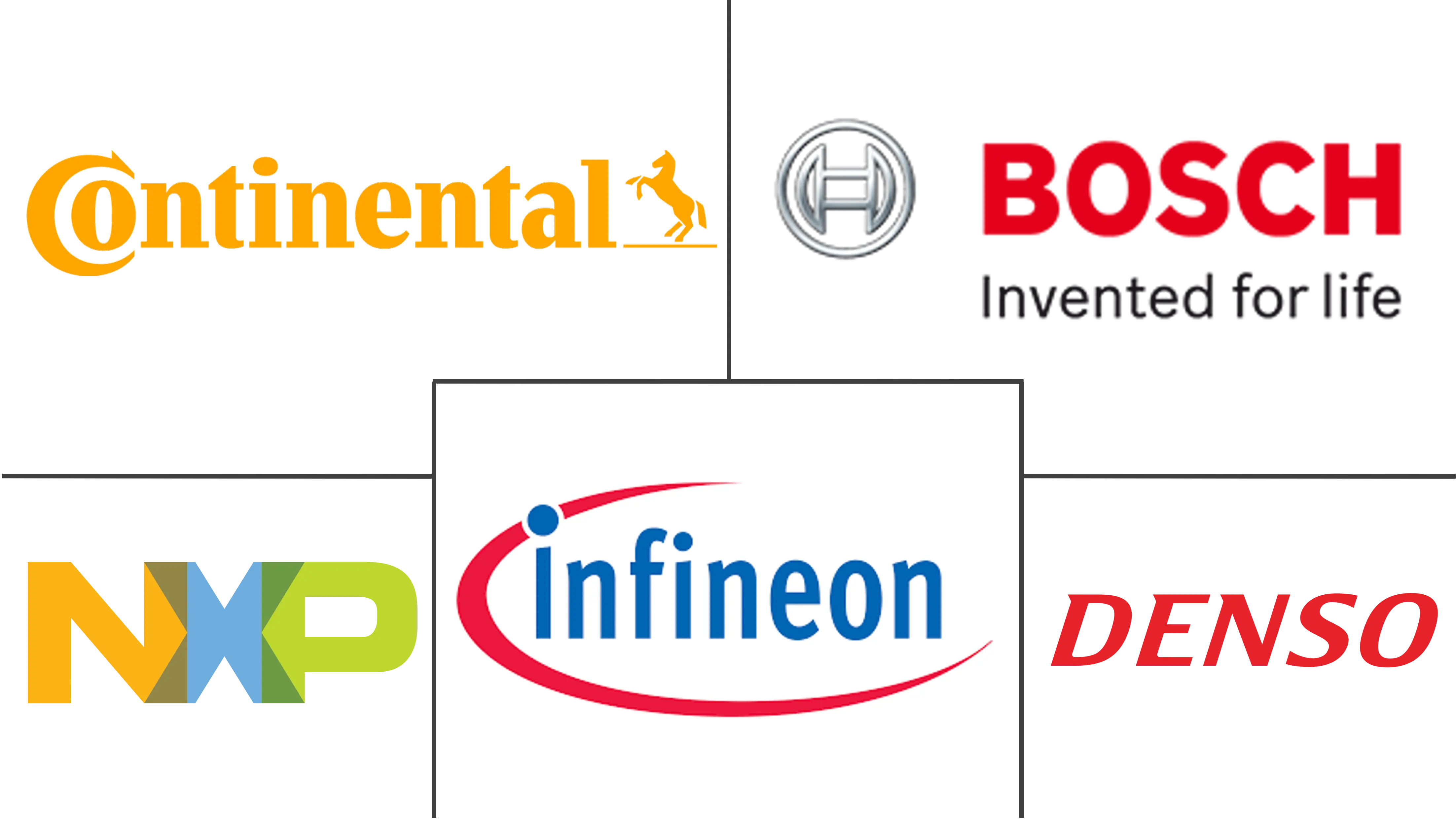Radar Sensors Market Size and Share
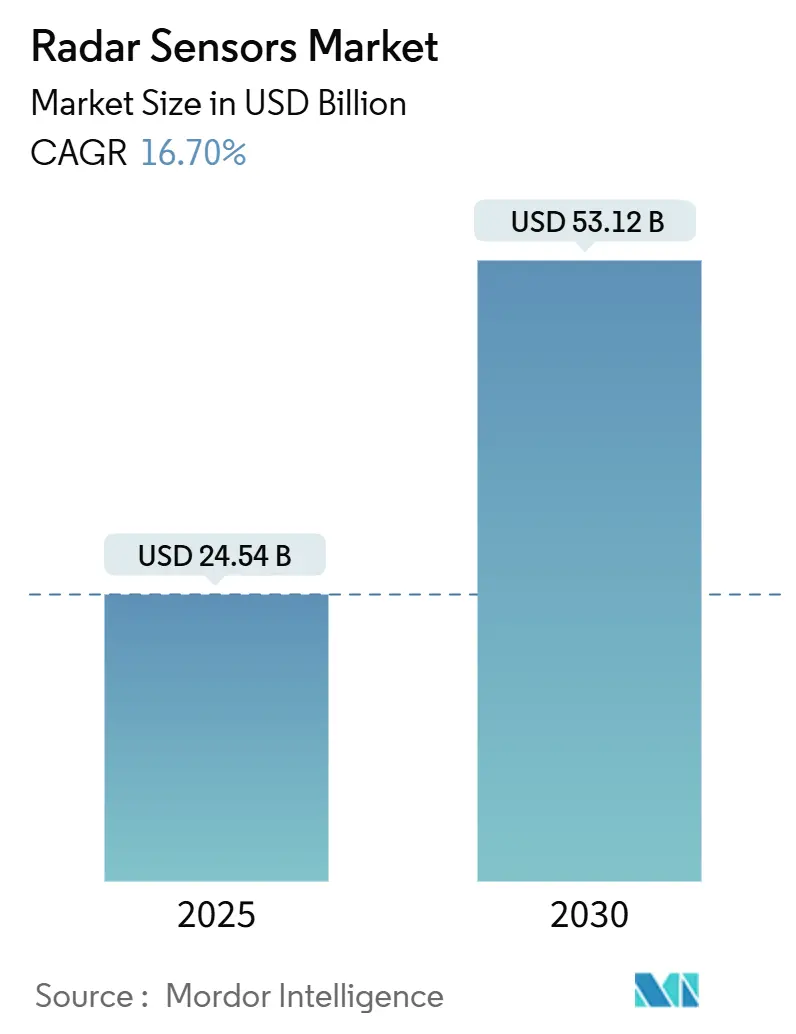
Radar Sensors Market Analysis by Mordor Intelligence
The radar sensor market size is at USD 24.54 billion in 2025 and is projected to reach USD 53.12 billion by 2030, expanding at a 16.7% CAGR. The rapid scaling reflects the technology’s migration from exclusive defense use to high-volume automotive safety, industrial automation, drone mapping, and smart infrastructure programs. Adoption is propelled by safety regulations such as the European Union General Safety Regulation, which mandates automatic emergency braking using 77–81 GHz radar in new vehicles. Supply-side catalysts include affordable millimeter-wave chipsets and gallium-nitride power devices that enhance range resolution while lowering size, weight, and power requirements. Robust military modernization in Asia-Pacific, expanding 5G-enabled road projects in Europe, and climate-resilient weather radar networks worldwide deepen addressable demand. Near-term challenges center on below-10 GHz spectrum congestion, calibration expenses for imaging arrays, and gallium supply risks stemming from China’s 98% production dominance.
Key Report Takeaways
- By type, non-imaging radar held 71% of radar sensor market share in 2024, while imaging radar is forecast to grow at an 18.4% CAGR through 2030.
- By frequency band, the 77–81 GHz segment led with 43% revenue in 2024; ≥94 GHz bands are projected to expand at a 21.7% CAGR to 2030.
- By range, short-range units (≤30 m) accounted for 56% of the radar sensor market size in 2024; long-range units (>150 m) are poised for a 15.6% CAGR.
- By technology, FMCW commanded 38% of 2024 revenues, whereas phased-array/AESA solutions are advancing at a 20.3% CAGR.
- By end-user, automotive applications captured 24% radar sensor market share in 2024; industrial automation is the fastest-growing end-user at a 16.8% CAGR.
- Asia-Pacific’s military programs and Europe’s smart-highway deployments underpin the highest regional growth momentum.
Global Radar Sensors Market Trends and Insights
Drivers Impact Analysis
| DRIVER | (~) % IMPACT ON CAGR FORECAST | GEOGRAPHIC RELEVANCE | IMPACT TIMELINE |
|---|---|---|---|
| Increasing Adoption of 77–81 GHz Radars in Automotive Safety Systems | 4.2% | Global, with early gains in Europe and North America | Medium term (2-4 years) |
| Surging Demand for Compact Imaging Radars in Drone-based Terrain Mapping | 2.1% | North America & EU, expanding to APAC | Long term (≥ 4 years) |
| Rising Military Spend on Active Electronically Scanned Array (AESA) Radars in Asia-Pacific | 3.8% | APAC core, spill-over to MEA | Short term (≤ 2 years) |
| Growing Need for mm-Wave Sensors in Industrial Robot Collision Avoidance | 2.9% | Global, concentrated in manufacturing hubs | Medium term (2-4 years) |
| Infrastructure Push for Smart Highways & Traffic-Monitoring Radars in Europe | 1.7% | Europe, with pilot programs in North America | Long term (≥ 4 years) |
| Climate-change-driven Uptake of Doppler Weather Radars in Coastal Regions | 1.3% | Global coastal regions, priority in Asia-Pacific | Medium term (2-4 years) |
| Source: Mordor Intelligence | |||
Increasing adoption of 77–81 GHz radars in automotive safety systems
Regulators and automakers endorse 77–81 GHz because it delivers longer detection ranges and sharper angular resolution than legacy 24 GHz devices. Continental’s ARS640 exceeds 300 m range and enables object classification fit for Level 2+ autonomy. China’s Ministry of Industry and Information Technology halted new 24 GHz radar approvals in 2022, compelling local OEMs to shift frequency bands. Bosch extended the band to motorcycles, equipping KTM bikes with 210 m range radar for adaptive cruise and blind-spot warning. These developments reinforce steady sensor penetration across vehicle classes, underpinning radar sensor market growth.[1]Continental Automotive, “Long Range Radars,” continental-automotive.com
Surging demand for compact imaging radars in drone-based terrain mapping
Multirotor drones use lightweight synthetic-aperture radars to generate sub-meter elevation models even in vegetation or cloud cover where optical payloads fail. Research shows 72.73% of mining exploration missions now favor multirotor over helicopter platforms, cutting survey cost by 60% while improving spatial granularity. The U.S. Geological Survey’s mobile radar observatory captures rainfall-runoff data minutes after wildfires, supporting emergency response. Such proof points fuel R&D investment in higher-bandwidth chipsets and on-board processing, broadening the radar sensor market.[2]MDPI, “Aerial Drones for Geophysical Prospection in Mining,” mdpi.com
Rising military spend on AESA radars in Asia-Pacific
South Korea awarded Hanwha Systems USD 40 million for L-SAM II multi-function radar, targeting high-altitude missile defense. Japan took delivery of Lockheed Martin AN/SPY-7 with GaN power amplifiers and 4,828 km land coverage, raising regional intercept capacity. The Philippines obtained Japanese MELCO FPS-3ME coastal radars valued at USD 98 million. Fast procurement cycles compress deployment timelines, accelerating the radar sensor market in defense channels.
Growing need for mm-wave sensors in industrial robot collision avoidance
Smart factories rely on non-contact sensing for human-robot collaboration. Texas Instruments’ AWRL6844 offers 98% occupancy detection using 60 GHz and trims system cost by USD 20 per vehicle when repurposed for in-cabin monitoring. OndoSense apex radar attains ±1 µm accuracy in steel milling lines, sustaining 500 Hz sampling under dust and heat. Profinet integration eases retrofit into PLC networks, quickening industrial adoption and strengthening the radar sensor market.
Restraints Impact Analysis
| RESTRAINTS | (~) % IMPACT ON CAGR FORECAST | GEOGRAPHIC RELEVANCE | IMPACT TIMELINE |
|---|---|---|---|
| Spectrum Allocation Constraints in Sub-10 GHz Bands | -2.8% | Global, acute in North America and Europe | Short term (≤ 2 years) |
| High Calibration & Maintenance Cost of Imaging Radar Arrays | -1.9% | Global, concentrated in automotive applications | Medium term (2-4 years) |
| Thermal management challenges in high-power mm-wave chipsets | -1.2% | Global, most pronounced in 77–81 GHz and ≥94 GHz deployments | Medium term (2–4 years) |
| Data-privacy concerns over 3-D people-tracking radars in retail | -1.5% | North America & EU, emerging in APAC | Short term (≤ 2 years) |
| Source: Mordor Intelligence | |||
Spectrum allocation constraints in sub-10 GHz bands
Radar developers compete with telecom and satellite operators for scarce sub-10 GHz slots. The U.S. Department of Defense runs more than 120 radars below 3 GHz, limiting civilian spectrum re-farm potential. The FCC recently tightened 24 GHz out-of-band limits to satisfy global rulings, forcing design changes. Certification queues can stretch nine months, delaying product launches and curbing near-term radar sensor market adoption.
High calibration & maintenance cost of imaging radar arrays
4D imaging stacks may hold 2,304 virtual channels, demanding meticulous factory alignment and frequent field recalibration to counter thermal drift. OEM Off-Highway cites specialist tooling burdens that raise lifetime costs for automotive makers. Continental’s aftermarket plan for sensor replacement beginning mid-2025 underscores the growing service overhead. Polarimetric arrays add twin-channel mismatch issues, inflating ownership cost and tempering radar sensor market expansion in price-sensitive segments.
Segment Analysis
By Type: Imaging Radar Drives Premium Applications
Non-imaging devices represented 71% of 2024 revenue, illustrating entrenched use in parking assistance and basic adaptive cruise. Imaging solutions, however, are forecast to post an 18.4% CAGR through 2030 as Level 2+ autonomy proliferates. NXP and sinPro’s 48-channel entry-level 4D unit reaches 1-degree azimuth and 2,000 point clouds per frame, signaling democratization of high-resolution perception. Imaging capability lets automated brakes distinguish pedestrians from roadside signs, pushing OEM fitment beyond luxury trims. The radar sensor market size for imaging-enabled modules is projected to reach USD 11.3 billion by 2030, capturing escalating software-defined vehicle budgets. Conversely, the cost-optimized non-imaging category retains dominance in delivery robots, forklift collision alerts, and rainfall estimation where identification finesse is less critical. Manufacturers bundle simple FMCW dies with antenna-in-package designs to lower bill-of-material cost and sustain the wider radar sensor market.[3] NXP, “Performance and Affordability: New 4D Imaging Radar,” nxp.com
Competitive roadmaps now combine embedded signal processors with edge AI acceleration to shrink latency. Continental’s ARS640 integrates neural network filtering to classify vulnerable road users in real time, raising functional safety metrics. On the materials side, silicon germanium front-ends challenge GaAs incumbents, promising sub-USD 10 die price at high volumes. This cost curve supports incremental imaging upgrades in mid-segment cars and paves the way for radar sensor market penetration in scooters and micro-mobility.
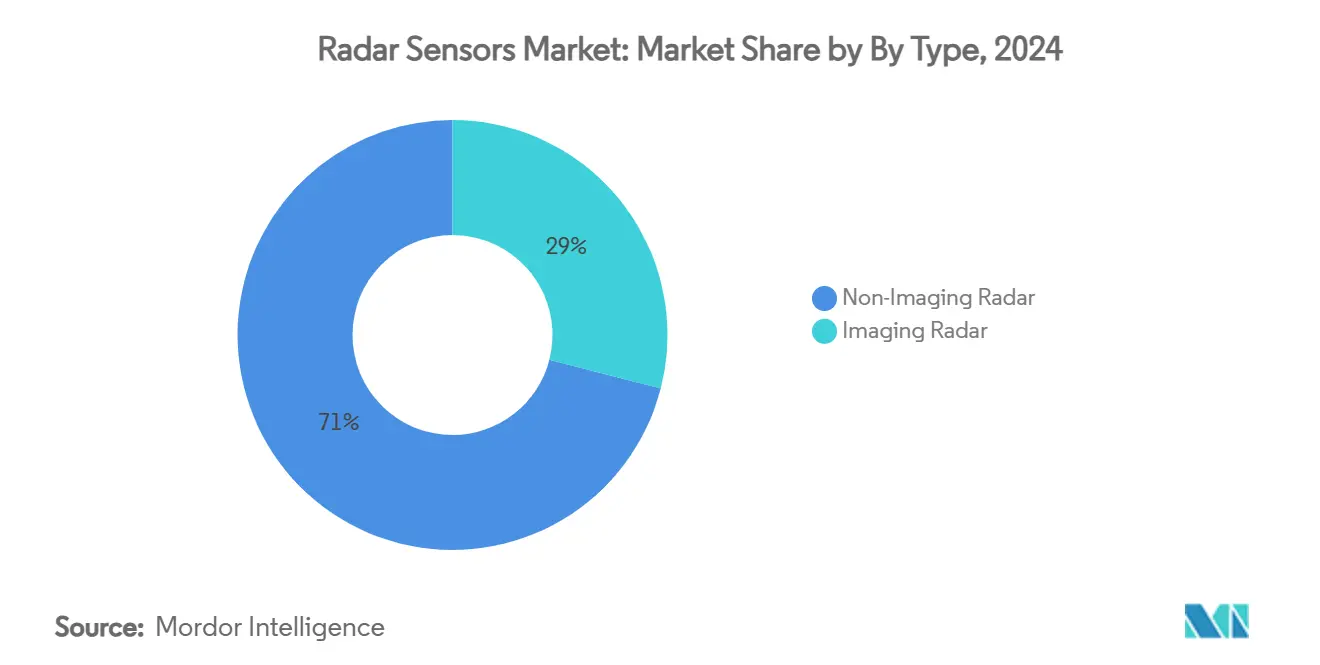
By Frequency Band: Higher Frequencies Enable Advanced Capabilities
The 77–81 GHz tier held 43% 2024 revenue due to a sweet spot between path loss and antenna aperture, enabling 250 m automotive detection while remaining cost-effective. Regulatory harmonization in Europe, China, and North America cut certification complexity and boosted the radar sensor market. STMicroelectronics’ 77 GHz transceiver sustains performance in snow or dirt, validating use in harsh roadside units. Above 94 GHz, ultra-wideband channels achieve sub-centimeter resolution prized in pavement crack monitoring and medical micro-Doppler imaging. With a 21.7% CAGR, ≥94 GHz shipments are set to more than triple by 2030 as wafer-scale GaN power amplifiers mature.
Spectrum below 10 GHz faces saturation, pushing developers to migrate upward. China no longer approves new 24 GHz automotive radars, accelerating global pivot. Short-range 60 GHz gear excels in cabin sensing, occupancy detection, and gesture control; Texas Instruments’ single-chip radar improves child presence alert accuracy to 98% without cameras. Blended multi-band architectures deploy 24 GHz corners, 77 GHz front units, and 60 GHz interiors, expanding the radar sensor market across multiple tiers.
By Range: Short-Range Applications Dominate Current Deployments
Short-range units (≤30 m) captured 56% revenue in 2024, driven by blind-spot and park-assist features. High-volume models ship more than four side sensors per car, underpinning the radar sensor market size for this range. Continental’s ARS51x is optimized for 0.2-2 m blind-spot monitoring with minimal latency, satisfying Euro NCAP tests. Long-range (>150 m) modules enjoy the highest CAGR at 15.6% as highway autopilot spreads and trucking fleets adopt forward collision avoidance. Premium SUVs often integrate a 300 m front radar paired with 200 m rear cross-traffic units to mitigate high-speed lane changes.
Medium-range (30–150 m) sensors bridge urban cut-in scenarios and pedestrian AEB. Bosch’s fifth-generation commercial-vehicle radar spans 170 m, detecting stopped traffic under bad weather. Range-on-demand firmware lets automakers tweak detection envelopes via over-the-air updates, optimizing power draw. Such adaptive configurations increase bill-of-material efficiency and reinforce radar sensor market acceptance across mass-market cars.
By Technology: FMCW Leads While Phased-Array Gains Momentum
FMCW accounted for 38% revenue in 2024, benefitting from low peak power and mature DSP pipelines suited to consumer budgets. Jaeger-loop PLL designs now reach 6 GHz sweep bandwidth, pushing range resolution under 4 cm. Meanwhile, phased-array/AESA formats are scaling rapidly with a 20.3% CAGR as GaN beamforming chips drop below USD 3 per element in defense volumes. South Korea’s L-SAM II radar underscores APS-enabled fire control where electronic steering delivers missile intercept geometry within milliseconds.
Pulsed radars persist in ATC and weather sensing due to unmatched range, although energy storage and magnetron maintenance add cost. MIMO and digital modulation schemes are researched for joint radar-communication, potentially enabling 5G vehicles to share raw range-Doppler cubes. China’s Greater Bay phased-array weather network illustrates the scale potential, with 64 T/R modules per face scanning an urban basin every minute. This convergence drives ecosystem partnerships and broadens the radar sensor market footprint.
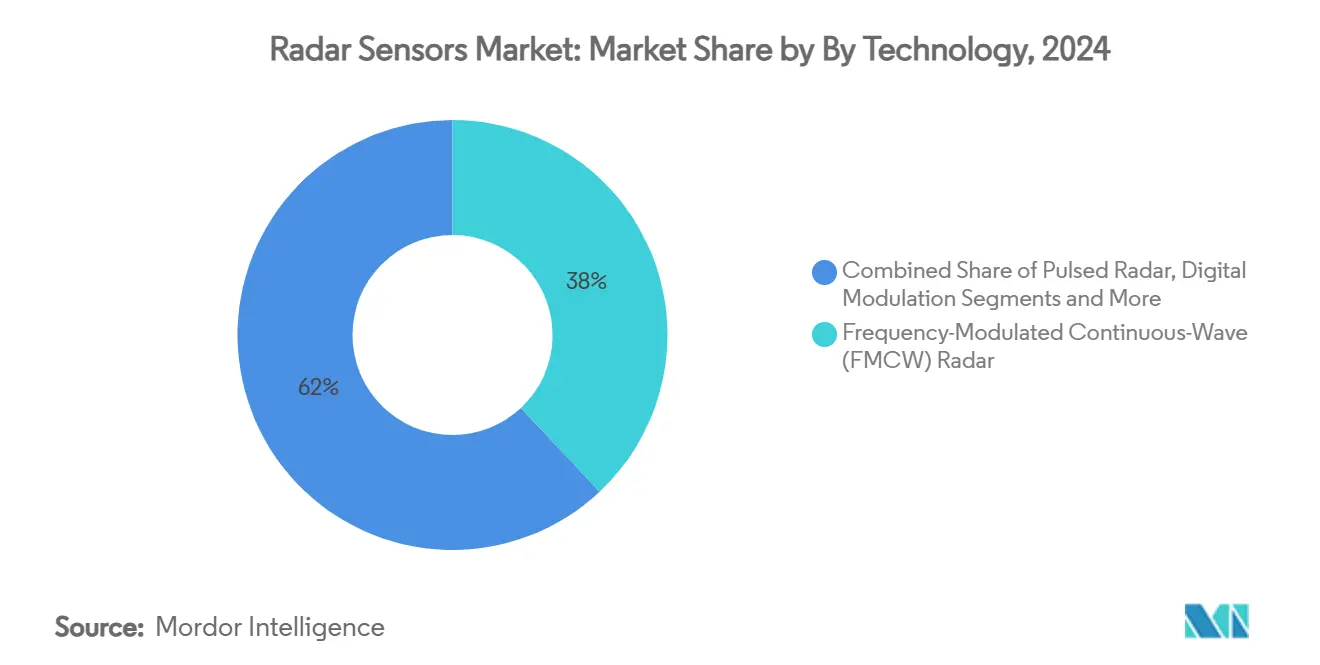
Note: Segment shares of all individual segments available upon report purchase
By End-User: Automotive Leads While Industrial Automation Accelerates
Automotive kept 24% share in 2024, cemented by legal mandates for automatic emergency braking across Europe and Japan. Mainstream sedans now incorporate up to eight radar nodes, triple the count in 2020, lifting sensor-per-vehicle volume and bolstering the radar sensor market. Industrial automation registers the fastest growth at 16.8% CAGR as collaborative robots proliferate. Texas Instruments’ AWRL6844 shows cross-market leverage, serving both in-cabin touchless interfaces and factory safety curtains.
Defense budgets in Asia-Pacific accelerate procurement of long-range AESA platforms, while weather services invest in X-band Doppler radars to bolster climate resilience. Healthcare explores privacy-preserving fall detection at 60 GHz, and smart cities embed radar in streetlights for adaptive lighting. Each new vertical diversifies revenue streams and cushions cyclicality in automotive demand, supporting a resilient radar sensor market.
Geography Analysis
North America remained the largest regional contributor in 2024, supported by advanced driver-assistance deployment and sizable defense upgrades. Gallium supply risk, however, threatens USD 602 billion of U.S. economic output, pushing policymakers to localize GaN epitaxy and recycle scrap csis.org. The United States also grapples with certification delays that slow civilian rollouts, while Canada scales automotive radar test facilities and Mexico benefits from near-shoring Tier-1 production lines.
Europe posts the highest forward CAGR due to unified safety laws and expansive smart-road investments. The EU’s AEB mandate ensures uniform sensor installation across vehicle classes, while national road agencies deploy radar for congestion analytics. smartmicro UK surpassed 1,000 roadside units, illustrating integrator momentum smartmicro.com. Supply-chain reshoring counters semiconductor scarcity, and 5G corridors embed radar hand-in-hand with V2X beacons.
Asia-Pacific leads defense and weather spending. Japan’s AN/SPY-7 roll-out and South Korea’s L-SAM II project typify high-budget programs driving domestic GaN foundry growth. China’s policy shift away from 24 GHz automotive radar accelerates migration to 77 GHz across local OEM plants. India’s USD 50 million weather radar order demonstrates public-sector appetite for precision meteorology. Collectively, these initiatives expand the radar sensor market beyond consumer mobility.
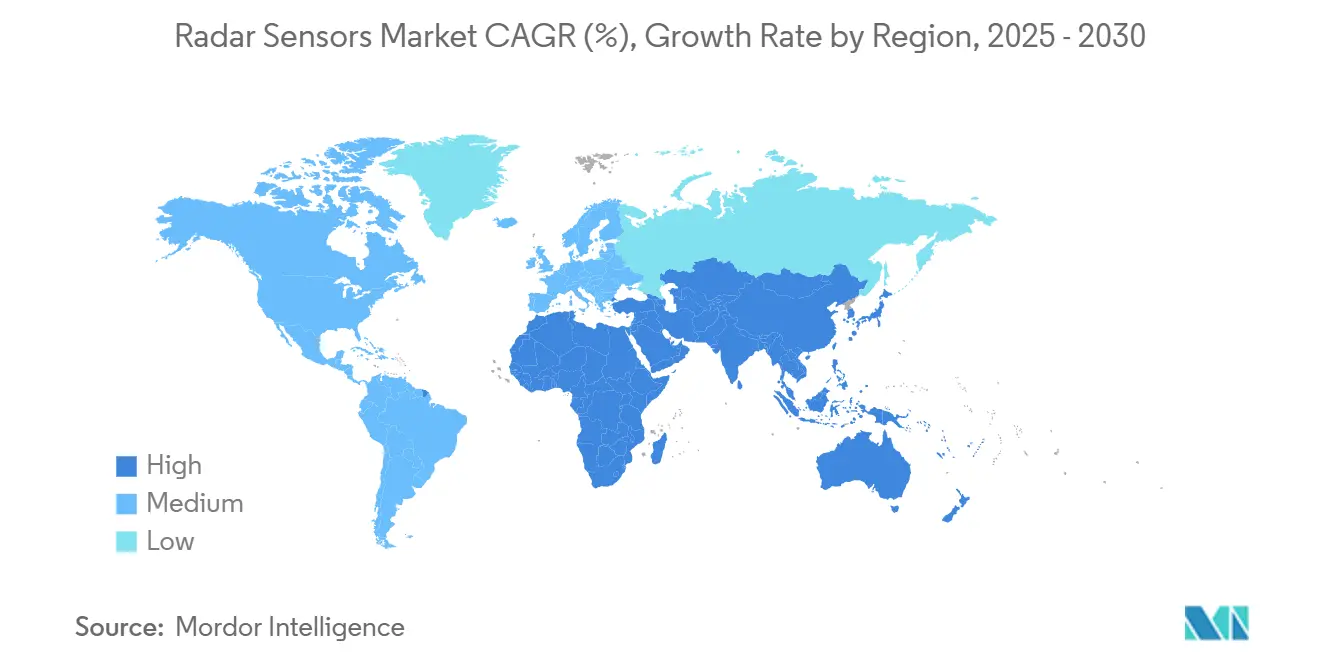
Note: Segment shares of all individual segments available upon report purchase
Competitive Landscape
The market is moderately fragmented. Continental, Bosch, and NXP leverage deep Tier-1 relationships and vertically integrated chip-to-module stacks. Continental’s aftermarket sensor rollout from 2025 diversifies revenue and builds brand stickiness. Bosch extends two-wheeler coverage with six new motorcycle radars that reach 210 m, addressing an underserved safety niche.
Semiconductor leaders such as Texas Instruments and STMicroelectronics emphasize high-performance SiGe and GaN RF front-ends. TI’s single-chip 60 GHz radar incorporates on-device AI, reducing system cost and enabling smart-cabin analytics. ST’s 77 GHz transceiver integrates antenna-in-package for compact automotive modules st.com. Meanwhile, Anduril’s purchase of Numerica in 2025 signals sector consolidation around sensor-fusion platforms for defense.
Start-ups pursue niche applications. OndoSense targets micron-grade steel gauging, bitsensing partners with NXP to shrink imaging radar cost, and smartmicro expands traffic monitoring. Supply-chain resilience has become a competitive differentiator, with vendors dual-sourcing gallium and exploring alternative materials to counter geopolitical pressure. Pricing power tilts toward suppliers owning proprietary GaN epitaxy and beamforming ASIC portfolios, shaping the radar sensor market playbook.
Radar Sensors Industry Leaders
-
Robert Bosch GmbH
-
Continental AG
-
Infineon Technologies AG
-
NXP Semiconductors N.V.
-
Denso Corporation
- *Disclaimer: Major Players sorted in no particular order
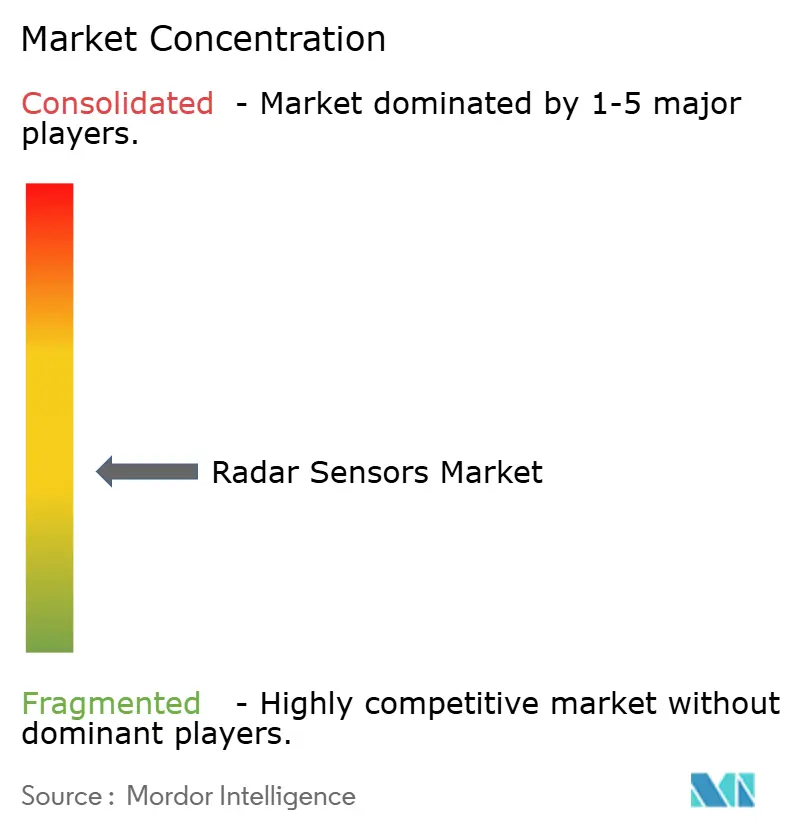
Recent Industry Developments
- January 2025: Anduril Industries acquired Numerica's radar and command-and-control business to enhance its defense technology capabilities, expanding the company's sensor fusion and surveillance portfolio for military applications
- January 2025: Texas Instruments launched the AWRL6844, the industry's first single-chip 60 GHz mmWave radar sensor with integrated edge AI processing, achieving 98% occupancy detection accuracy and reducing automotive implementation costs by USD 20 per vehicle
- January 2025: Japan Maritime Self-Defense Force received the first AN/SPY-7(V)1 radar system from Lockheed Martin, featuring S-band gallium nitride technology with 4,828-kilometer terrestrial range and 46,000-kilometer space-based target detection capabilities
Global Radar Sensors Market Report Scope
A radar sensor is a device that monitors the distance, speed, and motions of objects across great distances while also calculating the relative speed of the item being seen. This sensor determines the object's form, location, motion trajectory, and motion characteristics using wireless detecting technologies like FMCW (frequency modulated continuous wave).
The radar sensors market is segmented by type (imaging and non-imaging radar), range (short-range radar sensor, medium-range radar sensor, and long-range radar sensor), end user (automotive, security and surveillance, industrial, environment and weather monitoring, traffic monitoring, and other end users), and geography (North America, Europe, Asia-Pacific, Latin America, and Middle East and Africa). The report offers the market sizes and forecasts for all the above segments in value (USD).
| Imaging Radar |
| Non-Imaging Radar |
| Less than 10 GHz (HF/UHF/L-Band) |
| 24 GHz ISM Band |
| 60-64 GHz |
| 77-81 GHz |
| 94 GHz and Above |
| Short-range Radar Sensor (less than 30 m) |
| Medium-range Radar Sensor (30-150 m) |
| Long-range Radar Sensor ( greater than 150 m) |
| Pulsed Radar |
| Frequency-Modulated Continuous-Wave (FMCW) Radar |
| Phased-Array / AESA Radar |
| Digital Modulation and MIMO Radar |
| Automotive |
| Aerospace and Defense |
| Security and Surveillance (Fixed and Mobile) |
| Industrial Automation and Robotics |
| Environment and Weather Monitoring |
| Traffic Monitoring and Smart Infrastructure |
| Healthcare and Assisted-Living |
| Other End-Users |
| North America | United States |
| Canada | |
| Mexico | |
| Europe | United Kingdom |
| Germany | |
| France | |
| Italy | |
| Rest of Europe | |
| Asia-Pacific | China |
| Japan | |
| India | |
| South Korea | |
| Rest of Asia-Pacific | |
| Middle East | Israel |
| Saudi Arabia | |
| United Arab Emirates | |
| Turkey | |
| Rest of Middle East | |
| Africa | South Africa |
| Egypt | |
| Rest of Africa | |
| South America | Brazil |
| Argentina | |
| Rest of South America |
| By Type | Imaging Radar | |
| Non-Imaging Radar | ||
| By Frequency Band | Less than 10 GHz (HF/UHF/L-Band) | |
| 24 GHz ISM Band | ||
| 60-64 GHz | ||
| 77-81 GHz | ||
| 94 GHz and Above | ||
| By Range | Short-range Radar Sensor (less than 30 m) | |
| Medium-range Radar Sensor (30-150 m) | ||
| Long-range Radar Sensor ( greater than 150 m) | ||
| By Technology | Pulsed Radar | |
| Frequency-Modulated Continuous-Wave (FMCW) Radar | ||
| Phased-Array / AESA Radar | ||
| Digital Modulation and MIMO Radar | ||
| By End-User | Automotive | |
| Aerospace and Defense | ||
| Security and Surveillance (Fixed and Mobile) | ||
| Industrial Automation and Robotics | ||
| Environment and Weather Monitoring | ||
| Traffic Monitoring and Smart Infrastructure | ||
| Healthcare and Assisted-Living | ||
| Other End-Users | ||
| By Geography | North America | United States |
| Canada | ||
| Mexico | ||
| Europe | United Kingdom | |
| Germany | ||
| France | ||
| Italy | ||
| Rest of Europe | ||
| Asia-Pacific | China | |
| Japan | ||
| India | ||
| South Korea | ||
| Rest of Asia-Pacific | ||
| Middle East | Israel | |
| Saudi Arabia | ||
| United Arab Emirates | ||
| Turkey | ||
| Rest of Middle East | ||
| Africa | South Africa | |
| Egypt | ||
| Rest of Africa | ||
| South America | Brazil | |
| Argentina | ||
| Rest of South America | ||
Key Questions Answered in the Report
What is the current size of the radar sensor market?
The radar sensor market stands at USD 24.54 billion in 2025 and is projected to reach USD 53.12 billion by 2030.
Which frequency band dominates radar sensor deployments?
The 77–81 GHz band leads with 43% 2024 revenue due to its favorable range-resolution balance and global regulatory alignment.
Why is industrial automation the fastest-growing end-user?
Safety regulations for human-robot collaboration and the need for reliable detection in dusty or dim factories drive a 16.8% CAGR in industrial automation radar adoption.
How do spectrum constraints affect radar expansion?
Sub-10 GHz congestion and stricter emission rules prolong certification cycles, trimming the overall CAGR impact by about 2.8%.
What technology trend is reshaping automotive radar?
Imaging radar with embedded AI processing is spreading from premium to mass-market vehicles, enabling finer object classification for Level 2+ autonomy.
Which region will grow the quickest over the next five years?
Europe is poised for the highest regional CAGR, supported by mandatory AEB regulations and extensive smart-highway projects that rely on roadside radar networks.
Page last updated on:
